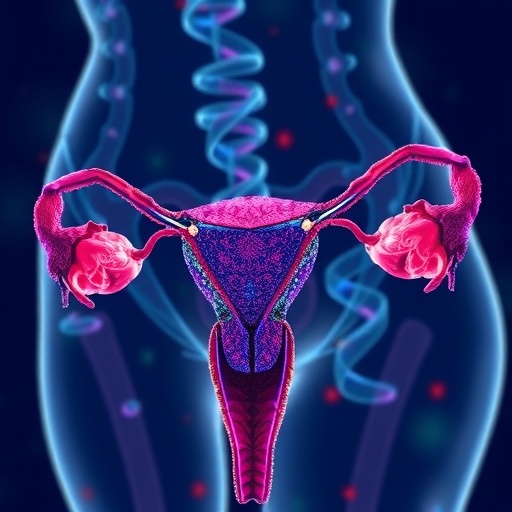Uterine fibroids (UFs) stand among the most prevalent hormone-dependent tumors affecting women globally, manifesting a complex disease architecture rooted in both genetic and environmental determinants. Recent scientific inquiry has ventured into elucidating how genetic predispositions, particularly loci identified through genome-wide association studies (GWAS), intersect with reproductive history and inflammatory conditions to modulate fibroid risk. Now, a groundbreaking case-control study pushes the frontier further by investigating the interplay between GWAS-identified single nucleotide polymorphisms (SNPs) and environmental exposures such as induced abortion and pelvic inflammatory disease (PID).
The research harnessed DNA samples from a cohort comprising 737 women diagnosed with uterine fibroids and 451 healthy controls, employing probe-based polymerase chain reaction assays to genotype ten UF-associated SNPs previously spotlighted in GWAS efforts. This methodological rigor set the stage for an in-depth exploration of gene-environment interactions, with a particular focus on how reproductive interventions and inflammatory states may differentially influence the penetrance and effect size of genetic risk factors.
Among the compelling findings, the SNP rs66998222 within the locus LOC102723323 emerged as a protective genetic variant, demonstrably associated with a decreased risk of developing UFs across the general population sample. Intriguingly, this protective effect intensified in women with a history of induced abortion, indicating a nuanced allelic impact modulated by reproductive history. The odds ratios marking this association were statistically significant, underscoring a gene-environment synergy that shapes fibroid susceptibility beyond the genetic architecture alone.
Conversely, the rs11031731 SNP, linked to the THEM7P and WT1 genes, was robustly correlated with an increased risk of uterine fibroids across the entire study population. This effect was magnified among women who had undergone induced abortions or those without a history of PID, revealing a complex genetic framework wherein environmental factors like inflammation and reproductive trauma differentially influence gene expression and subsequent disease manifestation. These findings suggest that genetic variants can exert context-dependent effects, potentiating or mitigating disease risk contingent on an individual’s environmental exposures.
Additional SNPs such as rs641760 in PITPNM2 and rs2553772 in LOC105376626 displayed protective associations, but only within specific environmental contexts tied to abortion history. These allelic variants seem to enact their influence via modulating hormone-sensitive transcriptional pathways and immune responses. Notably, rs1986649 within the FOXO1 gene correlated with delayed onset and attenuated growth rates of fibroids, hinting at genetic modulation of tumor kinetics and progression dynamics.
Mechanistically, the implicated GWAS loci converge on genes orchestrating pivotal biological processes including cellular proliferation, inflammatory signaling cascades, and hormone metabolism. These pathways collectively underscore the pathogenic nexus driving uterine fibroid formation and growth, positioning hormonal milieu and immune activation as critical intermediaries modulating genetic risk.
The study’s revelations herald a paradigm shift in our understanding of uterine fibroid etiology, advocating for personalized medicine approaches that integrate genetic screening with detailed reproductive and inflammatory histories. By delineating how environmental exposures like induced abortion and PID modulate the genetic risk landscape, this research paves the way for refined risk stratification models and potentially targeted interventions that consider both inherited genetic predispositions and modifiable environmental factors.
Future research trajectories should emphasize longitudinal design frameworks to capture the temporal dynamics of gene-environment interactions in diverse populations. This is crucial to validate the population-specific effects observed and to unravel the intricate biological mechanisms underpinning these interactions. Expanding these studies across multi-ethnic cohorts will enhance generalizability and provide insights into the heterogeneity of fibroid risk among different genetic backgrounds.
From a clinical perspective, these findings urge clinicians to adopt a more integrative approach when assessing uterine fibroid risk. Genetic testing combined with a comprehensive reproductive and inflammatory profile could enable early identification of high-risk individuals who might benefit from prophylactic strategies or tailored therapeutic interventions. The identification of context-dependent protective alleles also holds promise for novel therapeutic targets aiming to mimic such natural genetic defenses.
This research also stimulates a broader dialogue about the molecular crosstalk between hormonal regulation and immune responses in gynecological disorders. Understanding these intricate interactions will enrich our comprehension of fibroid biology and could catalyze the development of innovative pharmacological agents that modulate these pathways effectively.
In conclusion, the study underscores the critical need to contextualize genetic risk factors within the environmental and reproductive milieu to fully grasp their implications in uterine fibroid pathogenesis. It advocates for an integrative research approach combining genomics, epidemiology, and molecular biology to unravel the complexity of fibroid disease and heralds a future where precision medicine approaches can markedly improve women’s reproductive health outcomes.
Subject of Research: Genetic and environmental factors influencing uterine fibroid risk, with emphasis on gene-environment interactions involving GWAS loci and reproductive history.
Article Title: Gene–environment Interaction of GWAS Loci and Reproductive History in Uterine Fibroid Risk: A Case-control Study
News Publication Date: 14-Oct-2025
Web References: http://dx.doi.org/10.14218/GE.2025.00056
Image Credits: Olga Bushueva
Keywords: Inflammatory response, Uterine cancer, Abortion




